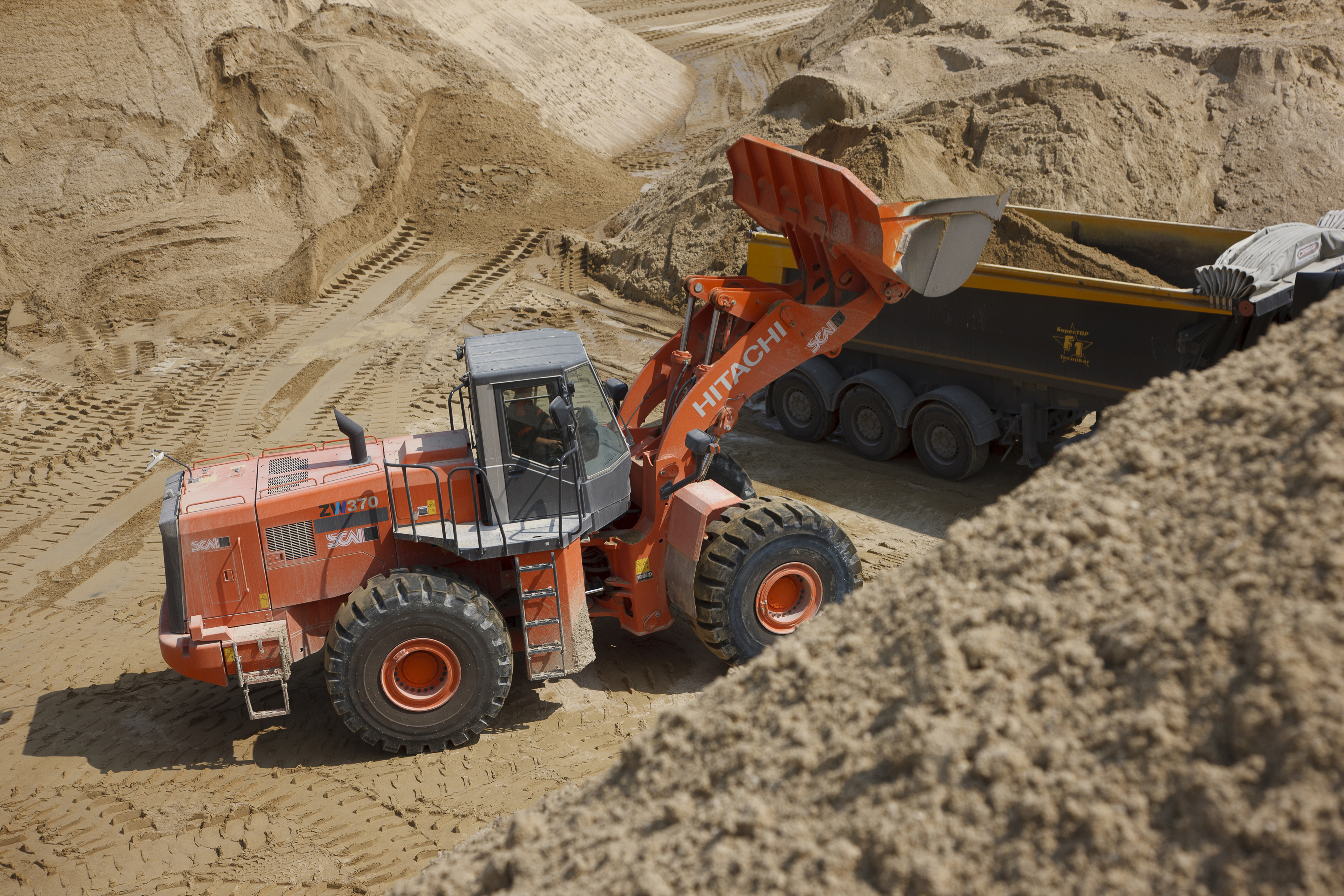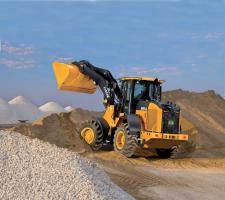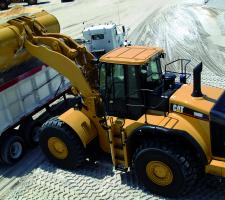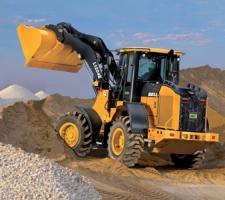
Wheeled loaders are often the quarry workhorse when it comes to loading. ABE takes a look at the developments that are helping to improve efficiency
Whether it is loading at the extraction face, moving stockpiles or loading delivery trucks or trains, wheeled loaders are a vital part of a productive quarry and probably one of the most heavily used items of equipment. This central role means that quarry operators are looking to get more uptime and greater efficiency from their new and existing fleets than ever before.
New technology is helping to improve the operation of new machines while greater uptake of extended service packages is giving quarry operators more confidence to age fleets where funds for investment are limited.
"The emissions regulations for the EU have been the main budget focus for research and development over the last few years," said Bell UK sales and marketing manager Josh Foster. "The process has been looking at how to implement the new Stage IIIB regulations and some organisations are using forward buying but by the end of next year I expect most new wheeled loaders to comply. The issue is that there is not a lot of benefit to the customer in terms of running costs from this development work - it is just to meet a legislative requirement."
Foster continued, "Some of the main product development in the last year or so has come from clever use of electronics with solid state and Canbus technology used to increase the level of automation. This is making machines easier to operate with features such as auto idle and shut down which can be set up on site to reduce fuel consumption. Main operational functions are also being increasingly automated with auto setting for tip height and kick to suit repeat truck loading applications where all the trucks or hoppers are the same height. This allows for a faster cycle.
"Return to dig height can also be set at the bottom of the cycle to prevent inexperienced operators scraping the floor unless they are carrying out housekeeping operations." Brasseur agreed and said, "The simplification of the operator workload by the automation of certain tasks like loading the bucket with auto-dig systems or avoiding tyre slippage thanks to automatic differential locks has been a major improvement." These automation capabilities help improve the longevity of the machine and also have training benefits for the operators on site. "GET is one of the highest running costs on a wheeled loader and these systems help to minimise those costs," said Foster.
Fuel focus
Improving fuel economy has been a major target for most manufacturers. "During the 2008-2009 crisis, many customers focused more on fuel consumption (litres per hour) instead of fuel efficiency (litres per tonnes) which normally provides a better return," explained Brasseur.
Electronic control of shifting has improved performance and the technology has been optimised in recent years, further boosting output while reducing wear and tear on the equipment. However, the OptiShift control system further improves transmission performance and delivers additional fuel economy according to the firm. A high torque at low engine speed is claimed, while load sensing hydraulics with variable piston pumps ensuring high working output and efficiency. The OptiShift system combines the best of mechanical and hydraulic technologies, according to Volvo, reducing fuel consumption in load and carry operations, while increasing hill-climbing performance and productivity. The system also allows faster loading cycles while the improved shifting provides a better drive response and increases operator comfort.
The development of OptiShift is the latest in a long line of class leading features, according to Volvo. The firm has long pioneered technology on its core products such as the ADTs and wheeled loaders. According to the firm's Arvid Rinaldo, "We were the first wheeled loader manufacturer on the market with an automatic transmission and the first with load sensing hydraulics." The OptiShift system offers other performance improvements and he said, "Another feature we have introduced is reverse by braking. When the operator changes direction, the machine brakes and changes gears automatically. There's less stress on the brakes and the torque converter so it reduces the wear on the machine and there's reduced stress on the operator and better fuel economy too." The system has been tested extensively and on-site trials with customers have backed up Volvo's claims for better economy. He said, "We have a customer in Germany and they borrowed one of our new L180s." He said that based on an application with a productivity of 200tonnes per hour, the fuel consumption of the new OptiShift version of the L180F was noticeably lower at 22.8litres per hour than for the firm's existing L180F at 26.4litres per hour. Volvo reckons its L180F OptiShift can deliver fuel economy of around 190-200litres/day compared with 250litres/day for the previous model.
In addition to new technology to improve fuel economy, both Cat and Volvo have been looking at the impact the operator can make on both new and older machines through improved driving techniques.
Rinaldo said, "We are committed to delivering solutions and future technologies. But it's one thing making the machine easy to operate and it's another getting into the operator's mindset." The firm has also set up its EcoOperator programme, in a bid to further address fleet running costs for its customers and Cat also has a similar programme available. This training sets out to teach experienced operators how to use machines more efficiently and reduce fuel consumption, as well as cutting down on overall wear and tear.
"Our EcoDrive operator training proves that having the best wheeled loader with a non-trained operator can be a big waste of money," said Brasseur. "We found that thanks to eco operator training programme up to 15% fuel saving were pretty common results.
"While our machines are relatively easy to operate, using the right operating techniques with the settings adapted to the application remains critical. For example, load-sensing hydraulic systems allow now to operate the machine at part throttle without a significant increase of cycle time, continuing to operate the machine at full throttle - as it was required in previous generation of machines - is simply a waste of fuel." Although pitched as an environmental benefit, many customers will perhaps be most interested in the cost efficiency this programme offers. By minimising wear and tear on the machines Volvo said that customers can cut a major chunk from fleet running costs through extending tyre life as well as other critical components. Reducing downtime and increasing uptime similarly boosts overall machine utilisation, allowing the customer to achieve a better overall cost per tonne for its fleet over the working life of the equipment.
The Volvo programme includes classroom sessions, use of simulators and practical training on machines, while Volvo CE says it can suit the syllabus to the needs of each customer as required. Contractor
Older machines
While the way machines are driven is changing, so is the way quarry operators manage their fleets as they try to lower investment costs.
"There has been a big change in ownership cycles," said Foster. "In the past three years or 6000hours was the standard replacement time. Now operators are looking to new ways of funding machines including lengthening ownership periods and 8000hours and even five years is not so unusual anymore. As a result customers want more warranty extensions as the want fixed repair and maintenance costs despite the greater aging of machines." Brasseur added, "During the crisis, some customers kept their machines longer and rationalised their fleet, moving equipment to higher demand sites. They are doing more work with fewer machines. Although the confidence in re-investing is still fragile, we recently saw the start of a replacement pattern which may be caused by the introduction of Stage IIIB in Europe."
Information increase
According to Foster, future development is likely to come from further development of telematics. "We think that although telematics has been around for about five years there is still a long way to go in terms of development," he said "The hardware is already there but the software is likely to change and improve to give better interpretation of data.
"Customers have information overload at the moment but with features like weighing as standard it is possible to deliver more than just fleet information and provide production details as well. But better software is needed so managers can easily use the information to mange the operation and not havethe mine the data to find what they need to." Brasseur agreed with the potential for improvements in information flow and said, "The development of the machine information technology, like VisionLinkTM, the new Cat Connected Worksite, will allow further improvements in operating costs, optimising machine availability and productivity, fleet management and enhancing safety.
"These progresses are made possible by the new generation of Cat Electronic Modules gathering parameters directly from the machines and by new communication tools compatible with either satellite or the cellular network (GSM).
"Cat Product Link is part of the modern Cat machine but it is important to note that this extended capability is now made available to the entire fleet, regardless of make or model, allowing all equipments to be monitored in one secure web-based application.
"There will be further focus on the reduction of operating costs and on the ease of operations like through the upcoming Caterpillar high efficiency power train featuring continuous variable transmission, presented at

















